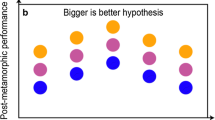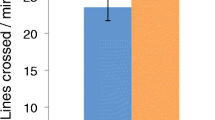Abstract
The behavioral responses of fishes to temperature variation have received less attention than physiological responses, despite their direct implications for predator–prey dynamics in aquatic ecosystems. In this paper, we describe the temperature dependence of swimming performance and behavioral characteristics of juvenile Pacific cod (Gadus macrocephalus; 75–125 mm total length). Maximum swimming speeds increased with temperature and body size. Routine swimming speeds of Pacific cod in small groups of similarly sized fish (N = 6) increased with body size and were 34 % faster at 9 °C than at 2 °C. The response to temperature was opposite that previously described for juvenile walleye pollock (Theragra chalcogramma), reflecting species-specific differences in behavioral responses. In a separate experiment, we demonstrated the effect of temperature on habitat selection of juvenile Pacific cod: Use of an artificial eelgrass patch in a 5-m-long laboratory tank was significantly greater at 9 °C than at 2 °C. These results illustrate that temperature affects a range of behavioral traits that play important roles in determining the frequency and outcomes of predator–prey interactions.




Similar content being viewed by others
References
Able KW, Fahay MP (1998) The first year in the life of estuarine fishes in the middle Atlantic Bight. Rutgers University Press, New Brunswick
Abookire AA, Duffy-Anderson JT, Jump CM (2007) Habitat associations and diet of young-of-the-year Pacific cod (Gadus macrocephalus) near Kodiak, Alaska. Mar Biol 150:713–726. doi:10.1007/s00227-006-0391-4
Bell WJ (1991) Searching behaviour. Chapman and Hall, London
Bell WH, Terhune DB (1970) Water tunnel design for fisheries research. Fish Res Bd Can Tech Rep No. 195. Fisheries Research Board of Canada, Nanaimo
Bennett AF (1990) Thermal dependence of locomotor capacity. Am J Physiol 259:R253–R258
Bevelhimer MS (1996) Relative importance of temperature, food, and physical structure to habitat choice by smallmouth bass in laboratory experiments. Trans Am Fish Soc 125:274–283
Brett JR (1964) The respiratory metabolism of and swimming performance of young sockeye salmon. J Fish Res Board Can 21:1183–1225
Brodeur RD, Wilson MT (1996) A review of the distribution, ecology, and population dynamics of age-0 walleye pollock in the Gulf of Alaska. Fish Oceanogr 5(Supp. 1):148–166. doi:10.1111/j.1365-2419.1996.tb00089.x
Brown JA, Pepin P, Methven DA, Somerton DC (1989) The feeding, growth and behavior of juvenile cod, Gadus morhua L., in cold environments. J Fish Biol 35:373–380. doi:10.1111/j.1095-8649.1989.tb02989.x
Ciannelli L, Brodeur RD, Buckley TW (1998) Development and application of a bioenergetics model for juvenile walleye pollock. J Fish Biol 52:879–898. doi:10.1006/jfbi.1997.0634
Cote D, Ollerhead LMN, Gregory RS, Scruton DA, McKinley RS (2002) Activity patterns of juvenile Atlantic cod (Gadus morhua) in Buckley Cove, Newfoundland. Hydrobiologia 483:121–127. doi:10.1023/A:1021367225993
Davis MW, Ottmar ML (2009) Vertical distribution of juvenile Pacific cod Gadus macrocephalus: potential role of light, temperature, food, and age. Aquat Biol 8:29–37. doi:10.3354/ab00209
Despatie S-P, Castonguay M, Chabot D (2001) Final thermal preferendum of Atlantic cod: effect of food ration. Trans Am Fish Soc 130:263–275
Fraenkel GS, Gunn DL (1961) The orientation of animals. Dover Publications, New York
Fraser NHC, Heggenes J, Metcalfe NB, Thorpe JE (1995) Low summer temperatures cause juvenile Atlantic salmon to become nocturnal. Can J Zool 73:446–451. doi:10.1139/z95-051
Griffith JS (1978) Effects of low temperature on the survival and behavior of threadfin shad, Dorosoma petenese. Trans Am Fish Soc 107:63–70
Hammer C (1995) Fatigue and exercise tests with fish. Comp Biochem Physiol 112A:1–20
Hofmann N, Fischer P (2002) Temperature preferences and critical thermal limits of burbot: implications for habitat selection and ontogenetic habitat shift. Trans Am Fish Soc 131:1164–1172
Humston R, Ault JS, Lutcavage M, Olson DB (2000) Schooling and migration of large pelagic fishes relative to environmental cues. Fish Oceanogr 9:136–146. doi:10.1046/j.1365-2419.2000.00132.x
Hurst TP (2007) Thermal effects on behavior of juvenile walleye pollock (Theragra chalcogramma): implications for energetics and food web models. Can J Fish Aquat Sci 64:449–457. doi:10.1139/F07-025
Hurst TP, Duffy TA (2005) Activity patterns in northern rock sole are mediated by temperature and feeding history. J Exp Mar Biol Ecol 325:201–213. doi:10.1016/j/jembe.2005.05.003
Hurst TP, Cooper DW, Scheingross JS, Seale EM, Laurel BJ, Spencer ML (2009) Effects of ontogeny, temperature, and light on vertical movements of larval Pacific cod (Gadus macrocephalus). Fish Oceanogr 18:301–311. doi:10.1111/j.1365-2419.2009.00512.x
Hurst TP, Laurel BJ, Ciannelli L (2010) Ontogenetic patterns and temperature-dependence of growth rate in early life stages of Pacific cod (Gadus macrocephalus). Fish Bull 108:382–392
Hurst TP, Moss JA, Miller JA (2012) Distributional patterns of 0-group Pacific cod (Gadus macrocephalus) cohorts in the eastern Bering Sea under variable recruitment and thermal conditions. ICES J Mar Sci 69:163–174. doi:10.1093/icesjms/fss011
Iafrate J, Oliveira K (2008) Factors affecting migration patterns of juvenile river herring in a coastal Massachusetts steam. Environ Biol Fish 81:101–110. doi:10.1007/s10641-006-9178-1
Irschick DJ, Garland T Jr (2001) Integrating function and ecology in studies of adaptation: investigations of locomotor capacity as a model system. Annu Rev Ecol Syst 32:367–396
Johansson F, Leonardsson K (1998) Swimming speeds and activity levels of consumers at various resource and consumer densities under predation risk. Can J Zool 76:76–82. doi:10.1139/cjz-76-1-76
Komers PE (1997) Behavioral plasticity in variable environments. Can J Zool 75:161–169. doi:10.1139/z97-023
Laurel BJ, Stoner AW, Ryer CH, Hurst TP, Abookire AA (2007) Comparative habitat associations in juvenile Pacific cod and other gadids using seines, baited cameras and laboratory techniques. J Exp Mar Biol Ecol 351:42–55. doi:10.1016/j.jembe.2007.06.005
Laurel BJ, Ryer CH, Knoth B, Stoner AW (2009) Temporal and ontogenetic shifts in habitat use of juvenile Pacific cod (Gadus macrocephalus). J Exp Mar Biol Ecol 377:28–35. doi:10.1016/j.jembe.2009.06.010
Lemons DE, Crawshaw LI (1985) Behavioral and metabolic adjustments to low temperatures in the largemouth bass (Micropterus salmoides). Physiol Zool 58:175–180
Linløkken AN, Bergman E, Greenberg L (2010) Effect of temperature and roach Rutilus rutilus group size on swimming speed and prey capture rate of perch Perca fluviatilis and R-rutilus. J Fish Biol 76:900–912. doi:10.1111/j.1095-8649.2010.02545.x
Luchin VA, Menovshchikov VA, Lavrentiev VM, Reed RK (1999) Thermohaline structure and water masses in the Bering Sea. In: Loughlin TR, Ohtani K (eds) Dynamics of the Bering Sea. University of Alaska Sea Grant, Fairbanks, pp 61–91
Milinski M (1993) Predation risk and feeding behaviour. In: Pitcher TJ (ed) Behaviour of teleost fish. Chapman and Hall, London, pp 285–305
Neat F, Righton D (2007) Warm water occupancy by North Sea cod. Proc R Soc B-Biol Sci 274:789–798. doi:10.1098/rspb.2006.0212
Noakes DLG (1992) Behavior and rhythms in fishes. In: Ali MA (ed) Rhythms in fishes. Plenum Press, New York, pp 39–50
Olla BL, Davis MW (1990) Effects of physical factors on the vertical distribution of larval walleye pollock Theragra chalcogramma under controlled laboratory conditions. Mar Ecol Prog Ser 135:105–108
Olla BL, Studholm AL, Bejda AJ, Samet C (1980) Role of temperature in triggering migratory behavior of the adult tautog Tautoga onitis under laboratory conditions. Mar Biol 59:23–30
Olla BL, Davis MW, Ryer CH, Sogard SM (1996) Behavioural determinants of distribution and survival in early stages of walleye pollock, Theragra chalcogramma: a synthesis of experimental studies. Fish Oceanogr 5(Suppl 1):167–178
O’Steen S, Bennett AF (2003) Thermal acclimation effects differ between voluntary, maximum, and critical swimming velocities in two cyprinid fishes. Physiol Biochem Zool 76:484–496
Ovadia O, Schmitz OJ (2002) Linking individuals with ecosystems: experimentally identifying the relevant organizational scale for predicting trophic abundances. Proc Natl Acad Sci USA 99:12927–12931. doi:10.1073/pnas.192245499
Overland JE, Salo SA, Kantha LH, Clayson CA (1999) Thermal stratification and mixing on the Bering Sea Shelf. In: Loughlin TR, Ohtani K (eds) Dynamics of the Bering Sea. University of Alaska Sea Grant, Fairbanks, pp 129–146
Parrish JK, Edelstein-Keshet L (1999) Complexity, pattern, and evolutionary trade-offs in animal aggregation. Science 284:99–101. doi:10.1126/science.284.5411.99
Peck MA, Buckley LJ, Bengtson DA (2006) Effects of temperature and body size on the swimming speed of larval and juvenile Atlantic cod (Gadus morhua): implications for individual-based modeling. Environ Biol Fish 75:419–429. doi:10.1007/s10641-006-0031-3
Pörtner HO, Peck MA (2010) Climate change effects on fishes and fisheries: towards a cause-and-effect understanding. J Fish Biol 77:1745–1779. doi:10.1111/j.1095-8649.2010.02783.x
Precht H (1958) Concepts of the temperature adaptations of unchanging reaction systems of cold blooded animals. In: Prosser CL (ed) Physiological adaptation. American Physiological Society, Washington, pp 50–78
Railsback SF (2001) Concepts from complex adaptive systems as a framework for individual based modeling. Ecol Model 139:47–62. doi:10.1016/S0304-3800(01)00228-9
Randall D, Brauner C (1991) Effects of environmental-factors on exercise in fish. J Exp Biol 160:113–126
Reynolds WW (1977) Temperature as a proximate factor in orientation behavior. J Fish Res Board Can 34:734–739
Reynolds WW, Casterlin ME (1979) Effect of temperature on locomotor activity in the goldfish (Carassius auratus) and the bluegill (Lepomis macrochirus): presence of an ‘activity well’ in the region of the final preferendum. Hydrobiologia 65:3–5
Righton DA, Andersen KH, Neat F, Thorsteinsson V, Steingrund P, Svedang H, Michalsen K, Hinrichsen HH, Bendall V, Neuenfeldt S, Wright P, Jonsson P, Huse G, van der Kooij J, Mosegaard H, Hussy K, Metcalfe J (2010) Thermal niche of Atlantic cod Gadus morhua: limits, tolerance and optima. Mar Ecol Prog Ser 420:1–13. doi:10.3354/meps08889
Smith RL, Paul AJ, Paul JM (1986) Effect of food intake and temperature on growth and conversion efficiency of juvenile walleye pollock (Theragra chalcogramma (Pallas)): a laboratory study. J Cons Int Explor Mer 42:241–253
Sogard SM, Olla BL (1993) The influence of predator presence on utilization of artificial seagrass habitats by juvenile walleye pollock, Theragra chalcogramma. Environ Biol Fish 37:57–65. doi:10.1007/BF00000712
Sogard SM, Olla BL (1998a) Behavior of juvenile sablefish, Anoplopoma fimbria (Pallas), in a thermal gradient: balancing food and temperature requirements. J Exp Mar Biol Ecol 222:43–58. doi:10.1016/s0022-0981(97)00137-8
Sogard SM, Olla BL (1998b) Contrasting behavioral responses to cold temperatures by two marine fish species during their pelagic juvenile interval. Environ Biol Fish 53:405–412. doi:10.1023/A:1007485417486
van Deurs M, Behrens JW, Warnar T, Steffensen JF (2011) Primary versus secondary drivers of foraging activity in sandeel schools (Ammodytes tobianus). Mar Biol 158:1781–1789. doi:10.1007/s00227-011-1691-x
Webb PW (1998) Swimming. In: Evans DH (ed) Fish physiology. CRC Press, Boca Raton, pp 3–24
Weetman D, Atkinson D, Chubb JC (1998) Effects of temperature on anti-predator behaviour in the guppy, Poecilia reticulata. Anim Behav 55:1361–1372. doi:10.1006/anbe.1997.0666
Weetman D, Atkinson D, Chubb JC (1999) Water temperature influences the shoaling decisions of guppies, Poecilia reticulata, under predation threat. Anim Behav 58:735–741. doi:10.1006/anbe.1999.1191
Wildhaber ML, Lamberson PJ (2004) Importance of the habitat choice behavior assumed when modeling the effects of food and temperature on fish populations. Ecol Model 175:395–409. doi:10.1016/j.ecolmodel.2003.08.022
Wootton RJ (1990) Ecology of teleost fishes. Chapman & Hall, London
Acknowledgments
The authors thank T. Tripp, M. Spencer, B. Knoth, and B. Laurel for assistance with fish collection and shipping. S. Haines and P. Iseri assisted with fish rearing and laboratory experiments. B. Laurel, C. Ryer, D. Righton, and an anonymous reviewer provided valuable comments on this manuscript. The findings and conclusions in this paper are those of the authors and do not necessarily represent the views of the National Marine Fisheries Service. Reference to trade names does not imply endorsement by the National Marine Fisheries Service.
Author information
Authors and Affiliations
Corresponding author
Additional information
Communicated by D. Righton.
Rights and permissions
About this article
Cite this article
Ottmar, M.L., Hurst, T.P. Thermal effects on swimming activity and habitat choice in juvenile Pacific cod (Gadus macrocephalus). Mar Biol 159, 2185–2194 (2012). https://doi.org/10.1007/s00227-012-2004-8
Received:
Accepted:
Published:
Issue Date:
DOI: https://doi.org/10.1007/s00227-012-2004-8




